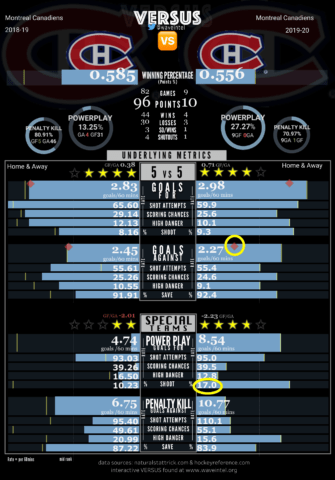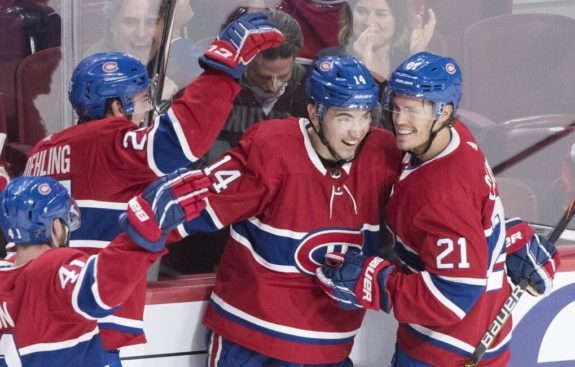We’ve reached the nine-game mark of the 2019-20 season with enough sample size to take a look at the Montreal Canadiens’ performance footprint. With a light week on the schedule, let’s examine how the Canadiens are performing, numbers-wise. Sometimes, the underlying statistics can help identify holes in a team’s game, or an adjustment in their system. And, for hockey-mad people like me, it’s always fun to see if the numbers align with the ‘eye test’.
The VERSUS Comparison Tool provides a comprehensive look at the team’s performance. The blue bar indicates league rank; the longer the bar, the better the team is performing in that category compared to all other NHL teams.
The data at the beginning of the bar is the raw data for the category. On the left side is the performance of the Montreal Canadiens last season, 2018-19. On the right side is the performance for this season so far.

At first glance, the 5-vs-5 numbers show the same pattern from last season to this season. Consistency in even-strength play is often a testament to the coaches’ systems. No surprise here; same coach, same system, same results.
A look at the special teams section shows a clear improvement on the power play, with some of the blue bars extending past the middle rank. So let’s take a closer look.
Canadiens’ Stellar Even-Strength Play
It was a rough transition from Michel Therrien to Claude Julien, but the Canadiens are now well into the second season of producing at an elite level during 5-vs-5 play. This season, not only have the Canadiens maintained the strong chances-for and against metrics, they have improved on some key aspects from last season – shooting percentage, from 8.16% to 9.3%, and save percentage from 91.9% to 92.4%.
One area of concern is the team’s ability to defend the lead, as indicated by the red diamond (circled in yellow) in the VERSUS graphic above. They rank well below average in the NHL allowing 3.56 goals-against per 60 minutes when leading.
Warning: Special Teams are Not So Special
When the underlying chances-for metrics are low, but the end result – goals – is high, it raises question marks. When it comes to the power play, some teams can get away with low chances-for and a high goal-rate. These teams are in an inclusive club, usually boasting a player or two capable of winning the Rocket Richard Trophy for most goals in a season. These players don’t need quantity or quality chances to score.

When the Canadiens have the same power play performance footprint (low chances-for and high goal scoring rate) as the Tampa Bay Lightning or the Washington Capitals, it raises a red flag. This does not mean they can’t continue with these results; it’s just worthy of the coaching staff’s continued attention.
Warning: The Penalty Kill can Kill You
It’s been well documented by several media outlets, that the Canadiens’ penalty kill has been painfully bad, and can even threaten playoff hopes similarly to how the power play was a nail in the coffin last season. So, is the penalty kill really that bad?
The short answer is yes. The long answer goes back to last season when the Canadiens’ penalty kill was good, but not great. It was good because of Carey Price’s above-average save percentage. But the underlying chances-against suppression numbers were all below average in the NHL last season. Fast forward to this season, the chances-against suppression numbers are not good again, and the end results – lots of goals against – is exasperated by a below-average save percentage.
Of course, the sample size is not large. And, if you’ve watched the games, many of the penalties have been of poor quality and frequent. I wonder how this plays on the psyche of the team and penalty killers. Is there such a thing as a ‘bad penalty’ to take? I think so. And I think it can apply to the Canadiens so far this season. There are so many factors that can play into the end results. Regardless, the results are not good and require immediate attention from all angles.
Special Teams Adjustments
During the course of a long season, teams often change tactics on the power play and force adjustments on the penalty kill. It was a good sign to see Claude Julien and staff change power-play tactics quickly after the first few games when the main play as to generate shots from the point as the primary source of chances. More aggressive, down-low plays seem to have taken over as option one. It will be interesting to see if success can be maintained in the absence of quality and quantity of chances.
Related: Canadiens Should Follow St. Louis Blues-print
Special teams can definitely make or break a season. There is no doubt Julien and his staff will be focusing on special teams this week. So far, the Canadiens special teams are still a question mark. I will reserve further judgement until the quarter-season mark.